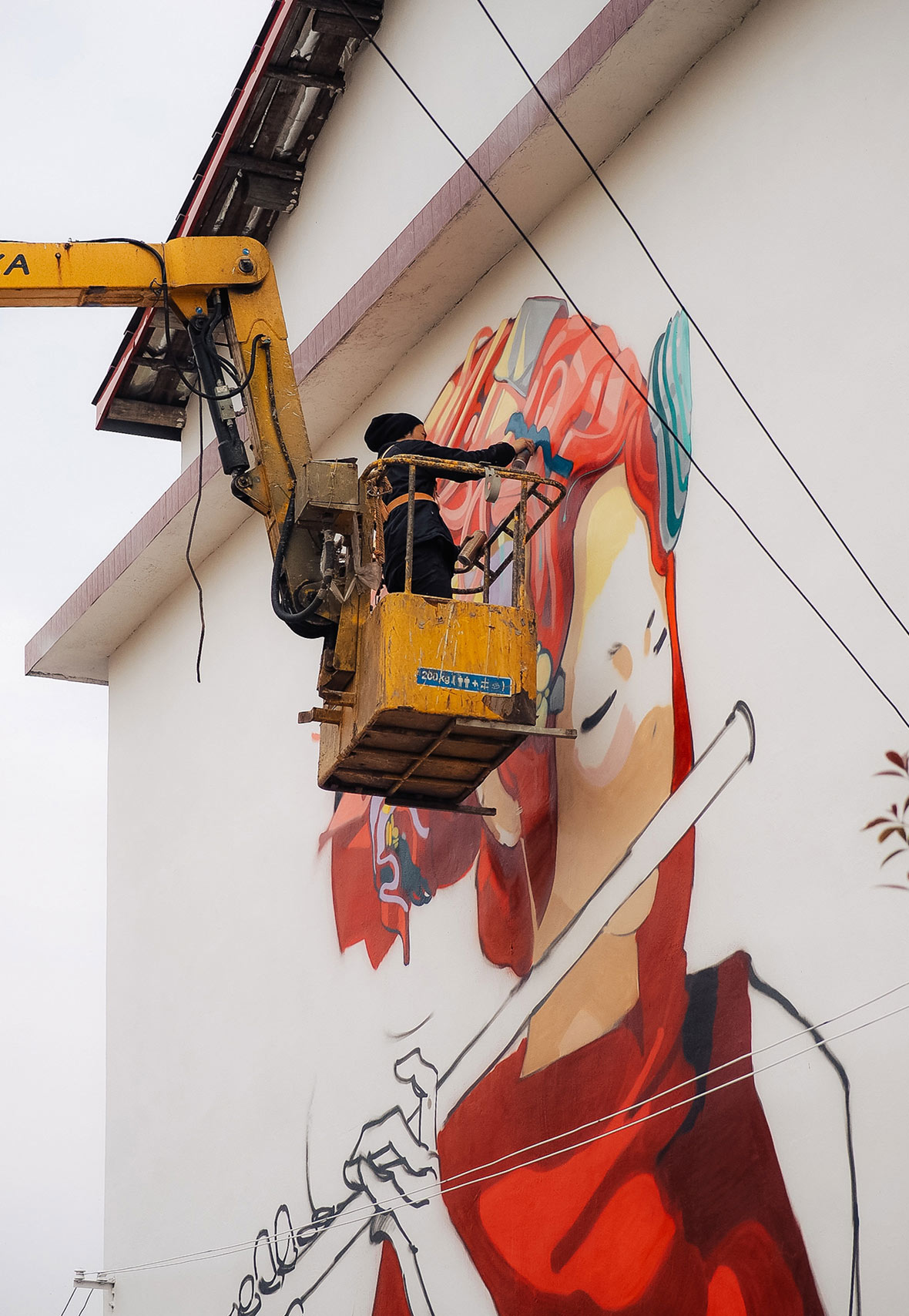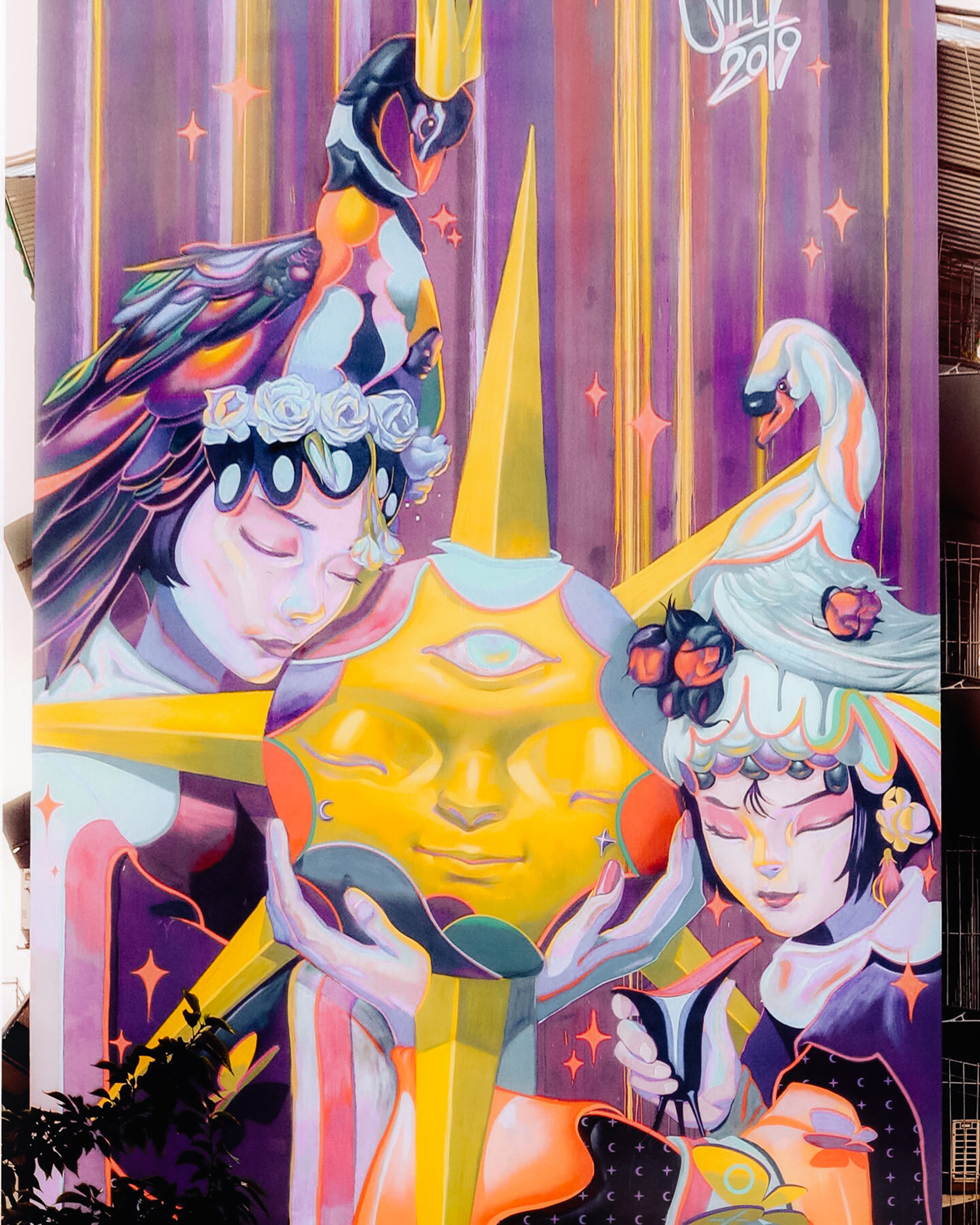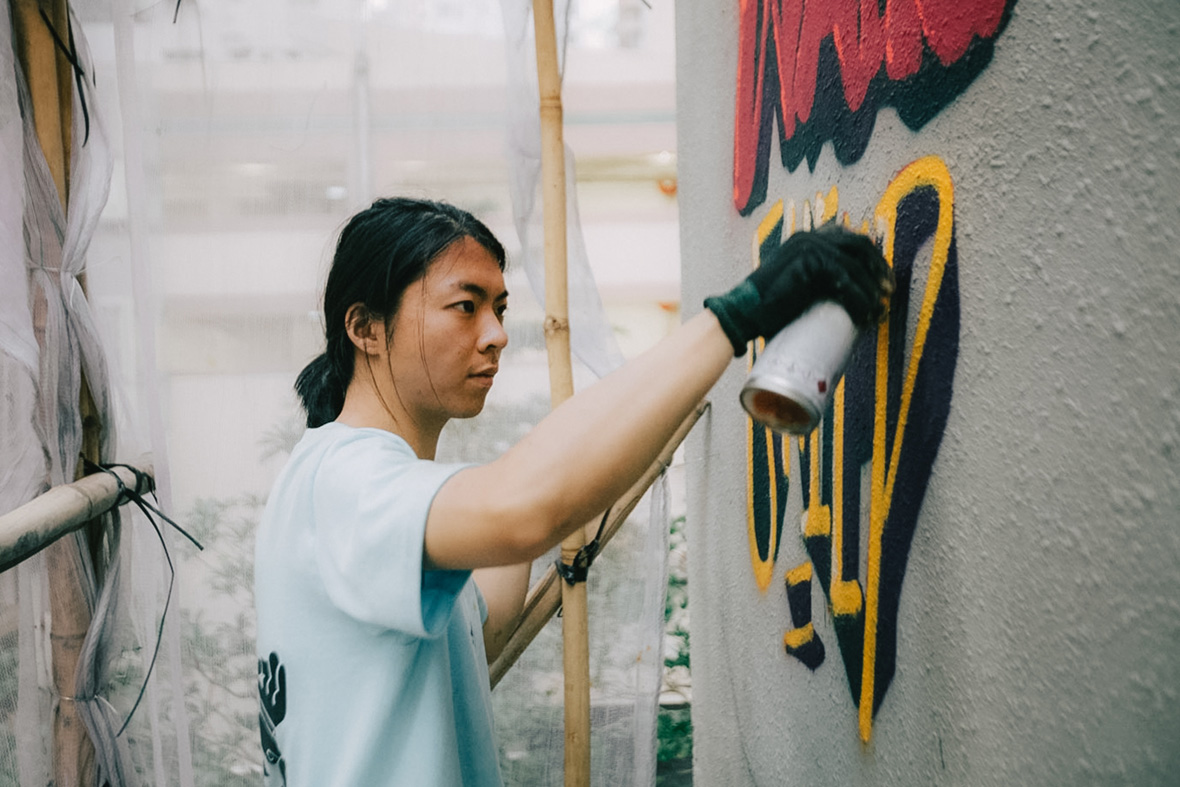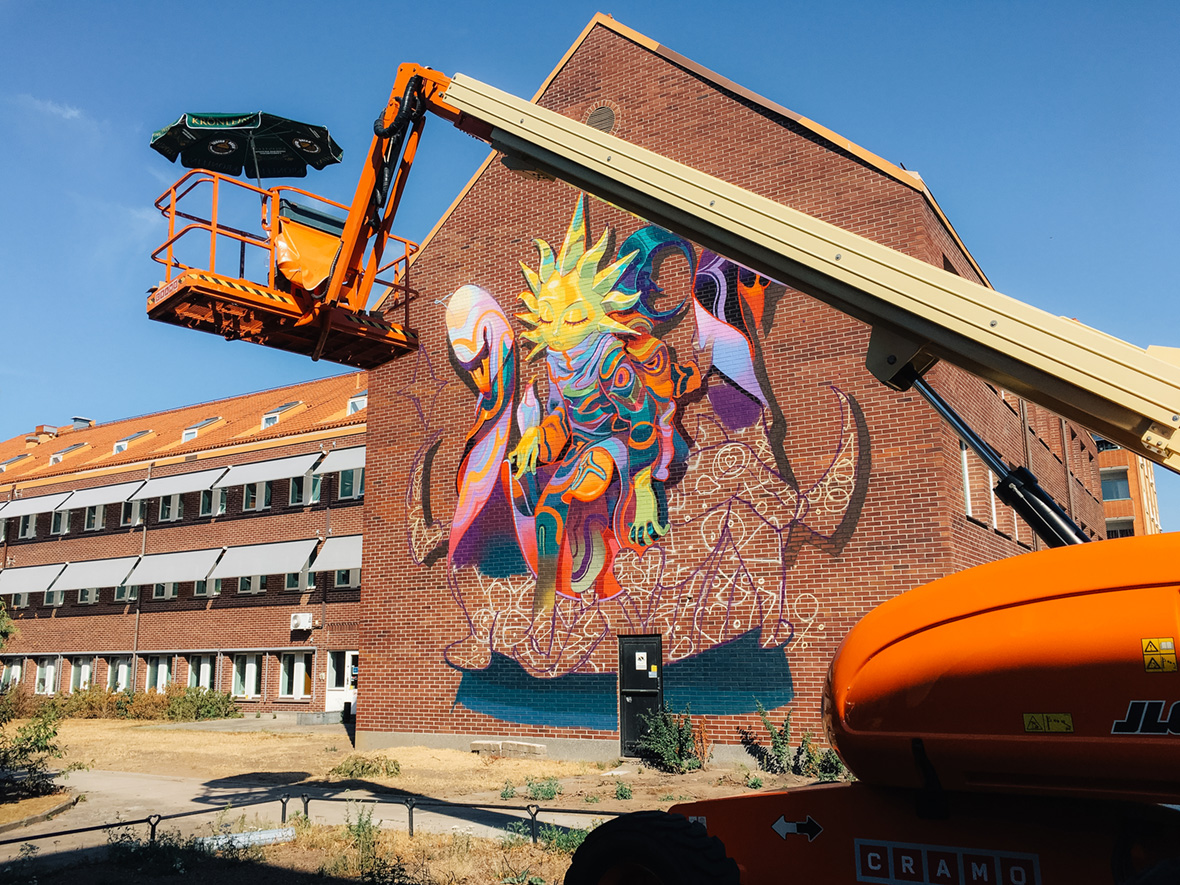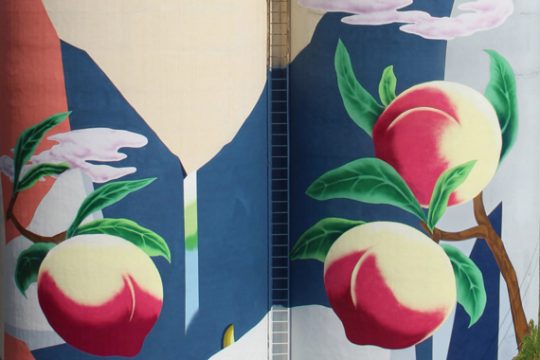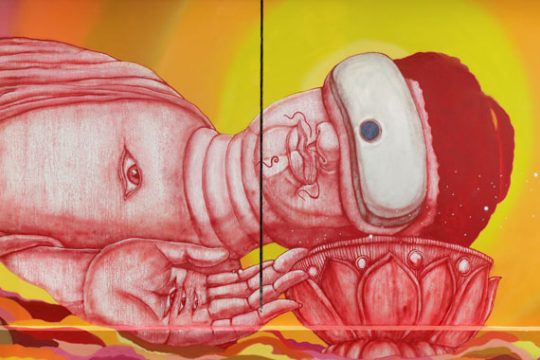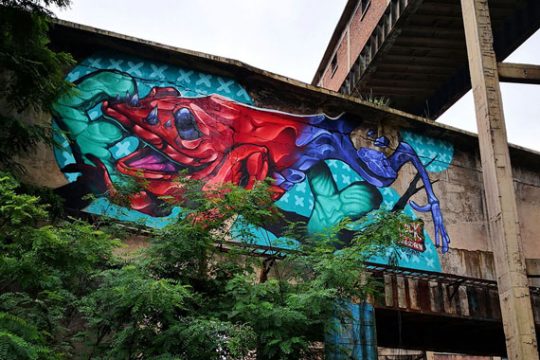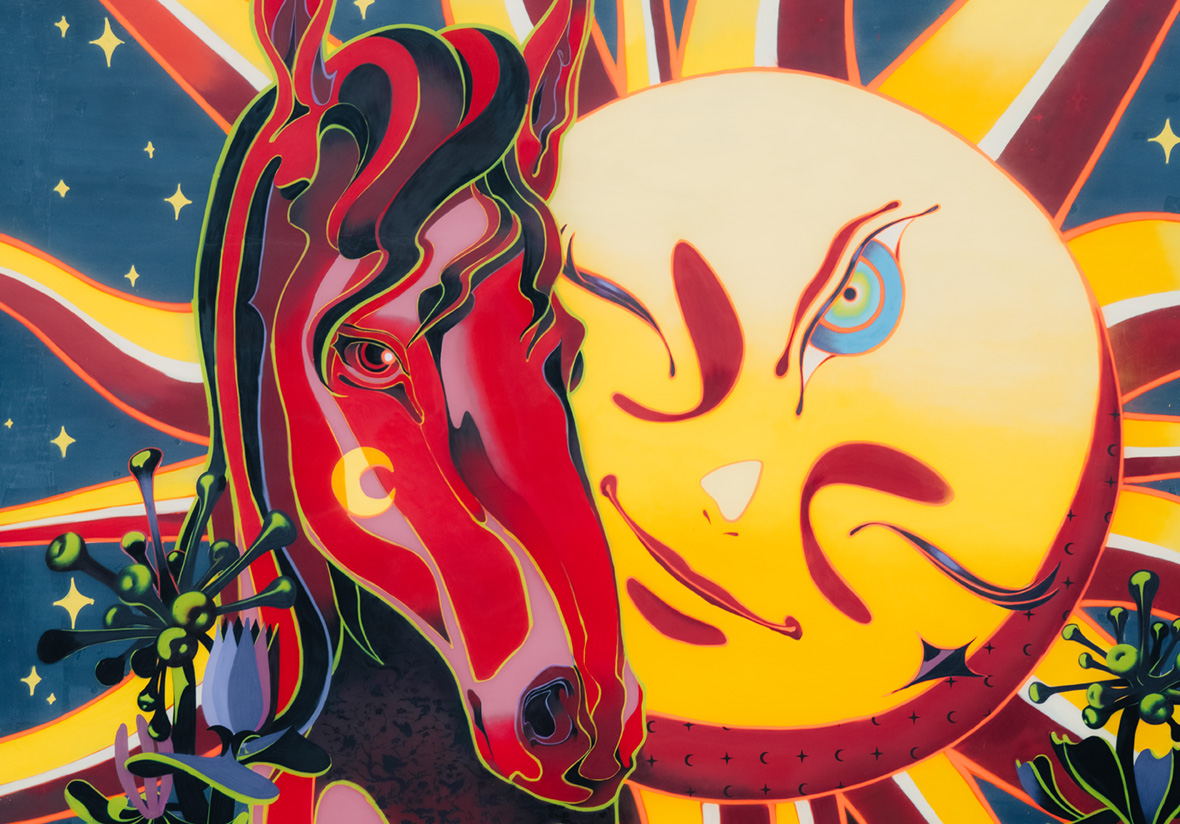
Under the sweltering June sun, street artist Sheep Chen is atop a crane lift, putting the finishing touches on a five-story-tall mural. The piece—covering the side of an entire residential building—is bold and imposing, and against the weather-worn facades of the surrounding buildings, its colors seem even more vibrant.
The mural, titled The Red Hare’s Sincerity, is a stone’s throw away from Chengdu’s Yi Guan Temple. The location’s significance can be found in the novel Romance of the Three Kingdoms; in the book, when the region’s ruling king Liu Bei was unable to retrieve the corpse of his fallen general, Guan Yu, a cenotaph honoring his passing was built in front of the temple. Giving nod to the tale, the centerpiece of Chen’s composition features the legendary stallion Red Hare, which was briefly owned by Guan Yu in the novel. The horse in Chen’s mural is mounted by a different owner though: a solar deity, one of the few recurring characters throughout his work. In this piece, the sun’s mouth is upturned in a benevolent smile.
On the ground, the crowd that’s gathered to watch the mural’s progress has only gotten bigger. Chen can’t help but crack a smile of his own. After all, working in public is his favorite thing about being an artist.
六月艳阳的成都,升降机发出隆隆的热浪,在一面居民楼侧边墙壁上,艺术家陈暘(Sheep Chen) 正在创作他的最新作品。五层楼高的大型壁画与市景街道形成强烈对比,乍听起来好像格格不入,而整幅作品却又在鲜艳大胆的颜色和轮廓上令人倍感舒适。这部名为《赤兔之诚》的作品,位于成都市衣冠庙地铁口,当地相传是三国演义中刘备祭拜关羽的地方。因此,Sheep 结合三国文化并以赤兔马为主题创作了这幅作品。除了赤兔马,壁画上 “太阳神” 是他作品中常见的元素,嘴角上扬的形象好似对当地居民带来某种福祉。路边围观的群众越来越多,Sheep 迎着阳光露出笑容,这是他多年来最爱做的事情之一 —— 城市公共壁画。
In China, public art first found steam by way of peasant paintings, an art form that was spurred on by government cultural initiatives between the ’50s and ’80s. Yet, despite the historic precedence, contemporary forms of public art never quite took off in the country. Chen believes that street art’s stunted growth in China is in part due to the fact that many domestic artists fail to ground their works in relatable, local context. A successful mural requires the artist to have a thorough understanding of the place they’re working in and the people they’re making it for, Chen says. “A mural should radiate an aura. It should feel surprising and leave an impression. A colorful mural in the concrete expanses of a city should be a sight for sore eyes.”
公共壁画作为公共艺术的一种,最早起步于中国五十至八十年代,当时在政府的倡导下,壁画(也就是所谓的 “农民画”)在农村十分盛行,其中大多作品歌颂着尚好的田园风光。但在如今,国内带有个人风格的壁画形式还凤毛麟角。毕竟是大体量作品,在壁画进行创作时,艺术家需要结合当地人文、地理等特色元素。Sheep 说:“每一个行走在壁画下的人都会被它的磁场所感染。她就像是一个精美的礼物,伫立在街角等待被你发现,让你在钢筋混凝土的森林里不经意地尝一口彩虹的味道。”
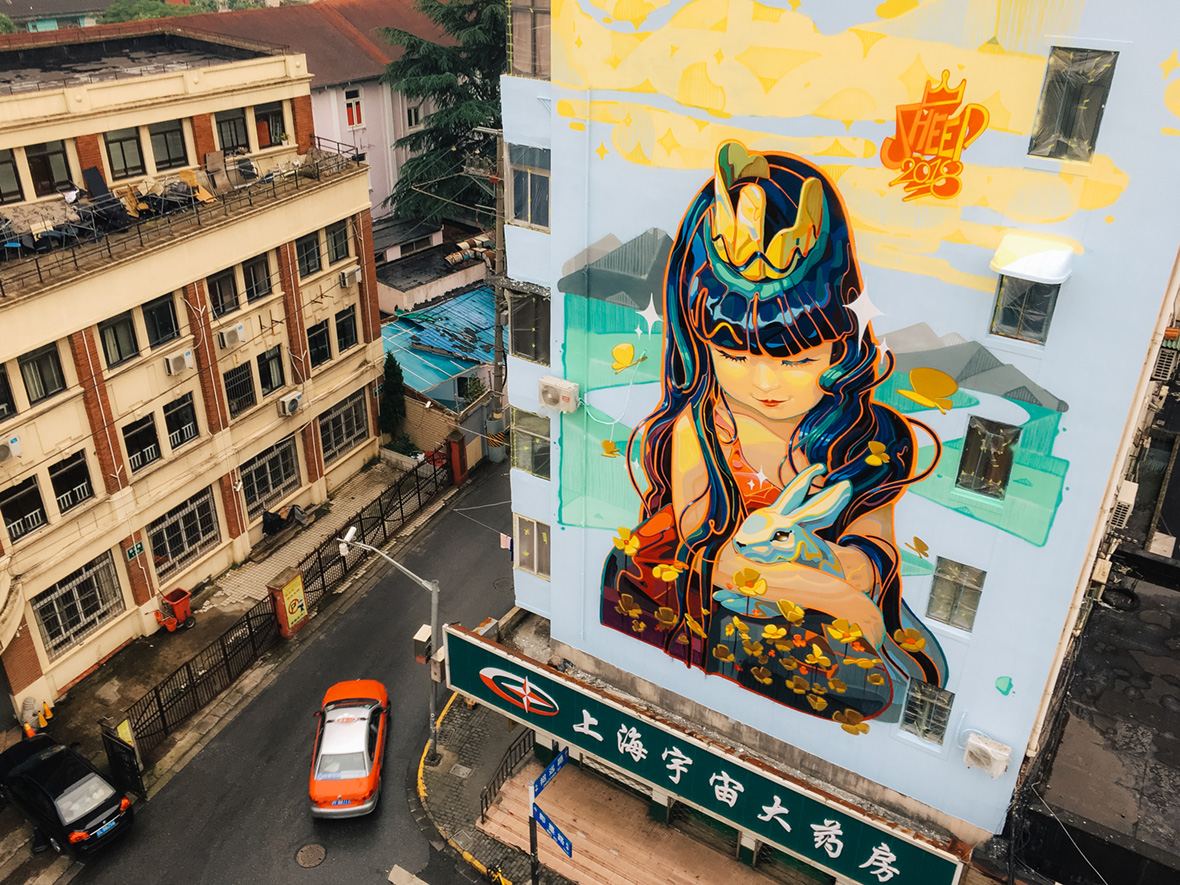
Chen refuses to work within the clichés of contemporary street art, opting instead to search for inspiration in myths and legends. Rinsed through his imagination and rendered in vivid colors, he turns common fairy tales and folklores into large-scale murals teeming with power. While Chen enjoys working in the realm of fiction, he finds it equally important to tap into the intangible aspects of everyday life for inspiration. “Wisdom, love, religion, and spirituality are all prevalent themes in my art,” he says. “I want my art to be optimistic. When you channel positivity, the cosmos will channel it back to you.” His cheerful works have brightened up walls in China, Singapore, the U.S., and more.
与常见的街头艺术不同,Sheep 大多数作品中的形象来自神话故事,并通过强烈的颜色和想象力,让角色散发出一种力量与灵气。这种灵气来源自他在日常生活中对玄奇妙想的观察,“宗教,开悟,爱和灵性体验是我在创作中最关注的主题。 ” 他笑着说道,“我的每一幅作品都带着美好的愿景,这样就能得到宇宙的助力,推动我去做好这件事。” 从创作至今,Sheep 把那份 “美好的愿景” 带到了很多不同国家和地区,从上海到新加坡、从关岛到夏威夷,这些作品仿佛与世界人民达成了某种共鸣。
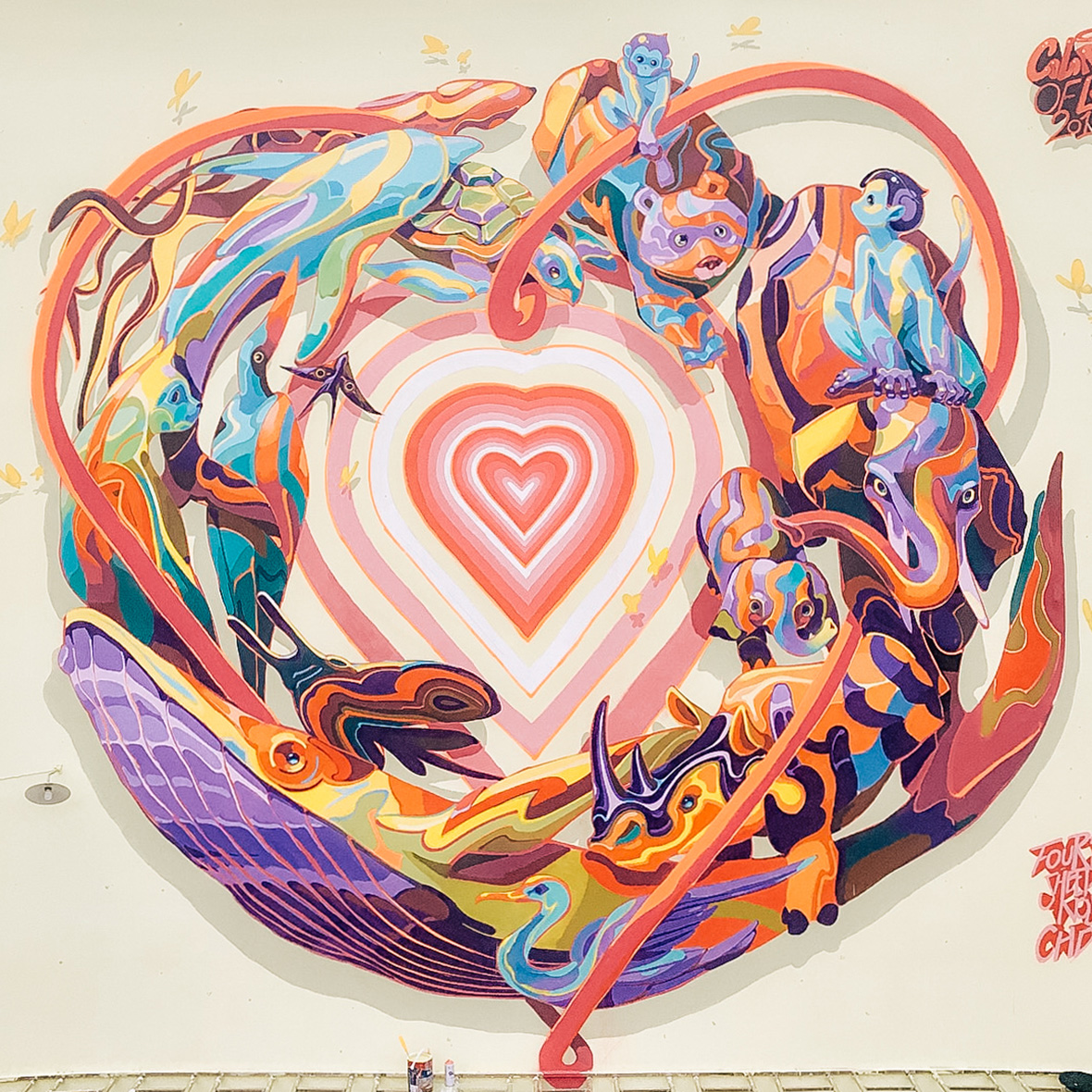
In 2008, when graffiti and street art were still fringe subcultures in China, Chen—still in high school at the time—was introduced to the art form when he met Hangzhou-based graffiti crew Lin Yin at a comics convention. Their expressive work struck a chord with Chen, who at the time was a rebellious teenager searching for identity and purpose. “The first time I sprayed a wall, I fell in love,” he recalls. “The smell of paint was like a hit of dopamine.”
2008 年,街头艺术在中国还并未普及。高中时期的 Sheep 在一次漫画展中认识了杭州涂鸦团队“麟隐”,从此与涂鸦文化结缘。当青少年的叛逆和求异心理与涂鸦艺术碰撞,让 Sheep 找到了强烈的身份认同感,他说:“第一次用喷漆在墙上胡作非为的时候我就彻底爱上这种感觉,喷漆的味道一度成为了我的迷幻药。”
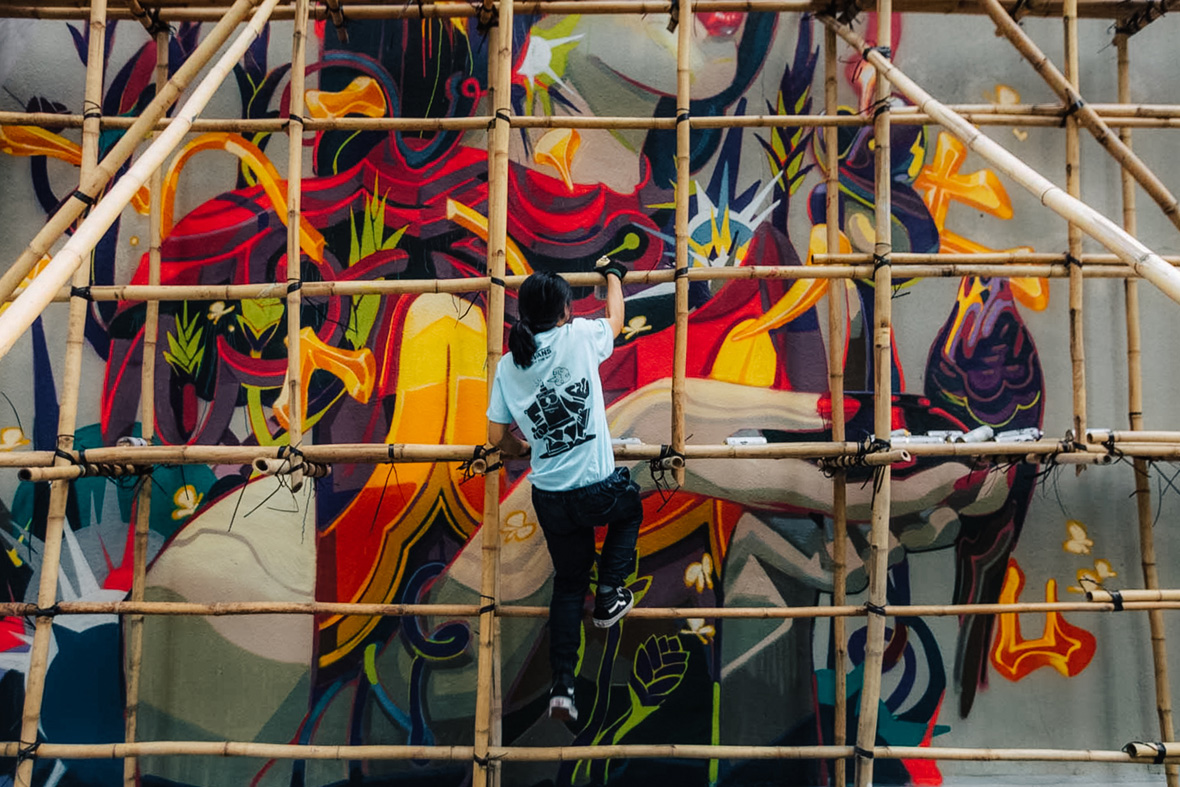
Over the years, Chen has found tremendous success within the Chinese street-art scene, but the self-skepticism and second guessing that marked his younger years have stuck. He treasures this self-awareness and inwardly critical gaze, considering there to be many parallels between his introspective approach to making art and Buddhist practices. He goes as far as to say the artistic journey is a spiritual pilgrimage, and an artist reaches “enlightenment” once they hone in on their own style.
多年创作以来,Sheep 坚持在不断怀疑和推翻中创作,并这样的过程称作为 “修行”。在他看来,创作风格的塑造就像是一场朝圣,在不断对内心的追问下,找到最适合自己的风格。
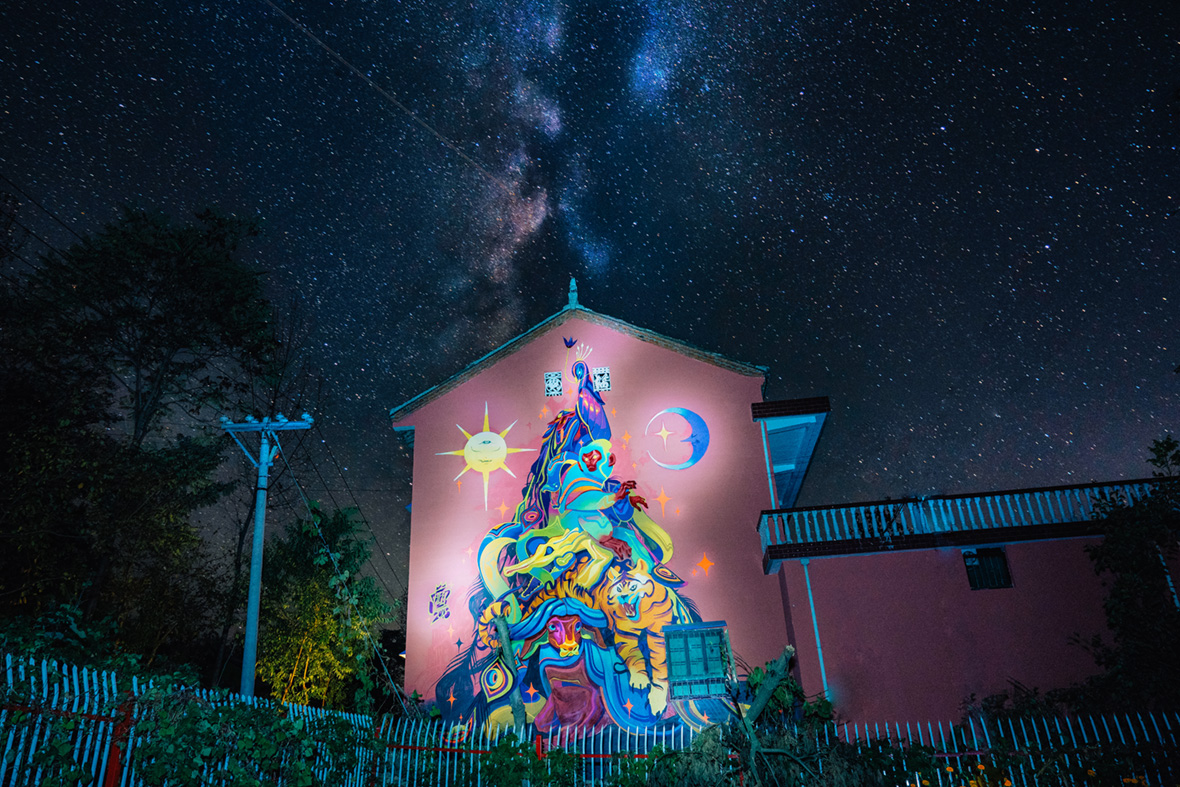
Born in Jiaxing, a sleepy city in China’s Zhejiang Province, Chen sees his hometown as the perfect setting for making art. Jiaxing is an incredibly calming place to him, a safe haven where he can declutter his mind and reorient himself. He’s lived for stints of time in larger cities, such as Wuhan and Singapore, but he always returns home. “When I’m back home in Jiaxing, everything feels unhurried,” he says. “My thoughts can easily take on a visual form.”
浙江嘉兴地处江南水乡,青枫江上的景观造就了温柔、感性的城市特点。对于出生在这里的 Sheep 来说,嘉兴就是最适合修行的地方。每当他回到家乡,创作中所做所想的一切都在肚中慢慢消化,他说:“在家乡嘉兴,自己的一方世界把所思所想都变成画面,不争不抢,不急不躁。” 尽管因为涂鸦事业,他曾旅居在新加坡和武汉,但如今他还会经常回到故乡。
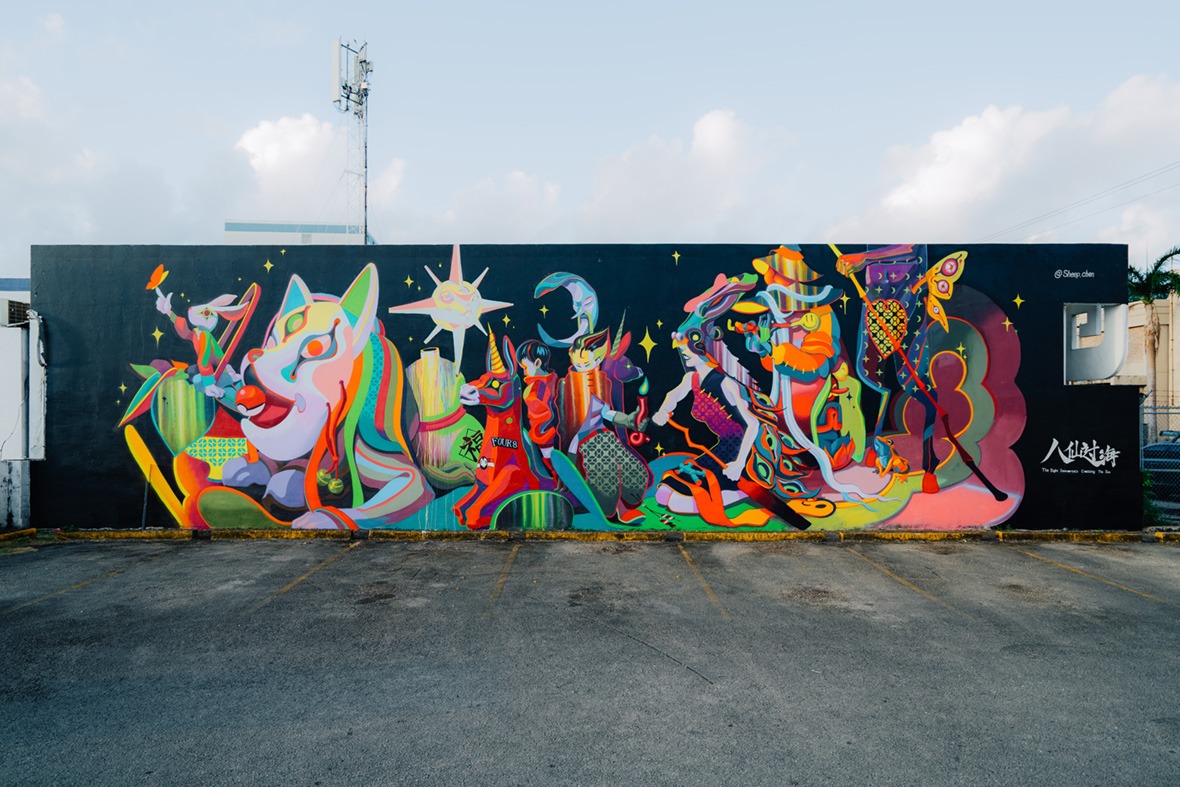
These visualizations of Chen’s conscious and subconscious mind often appear in the form of disparate religious and cultural symbols, whether it be The Eight Immortals of Chinese mythology or the mysterious unicorns of Western art. He believes tradition and culture are parts of life that best capture the spiritual side of our physical existence. This interest in spirituality has been a defining factor in his artistic growth—Chen considers Buddhist meditation to be one of his biggest inspirations to date.
In 2017, Chen went on a meditation retreat at Nanchan Temple. There, he gained a deeper appreciation of yin and yang. Since then, his art has become heavily influenced by the notion of duality. One of the most prominent visualizations of yin and yang in his work is the appearance of the sun and the moon. “Yin and yang, and the notion of achieving balance are key inspirations lately,” he says. “Being mindful of the world’s duality has afforded me new perspectives in art and changed the way I live my life.”
From 2018 onwards, this pursuit of balance has transformed his creative process. Chen now even looks to feng shui and its five elements—wood, fire, earth, metal, and water—when planning a mural. “The colors and shapes I use are dependent on the location,” he says. “If there isn’t a body of water nearby, I’ll use more blues and softer lines. If there’s a lack of metal, I’ll use more whites and angular shapes.”
观看 Sheep 的作品,你很难不会被画面中的深厚的文化或宗教元素所吸引,无论是位于关岛的八仙过海图,还是迈阿密的独角兽形象。他承认自己对不同民族、和文化的喜爱,也更执迷于物质世界背后的精神世界。出于对佛教禅修的兴趣,2017 年,Sheep 独自前往南禅寺内观修行。期间,他深刻领悟到阴阳平衡的意义,并将其运用到之后的创作当中,他说:“阴阳平衡的观念是我很大的灵感来源,其是一种看待事物的眼光,也是一种生活的方式。 ”
2018 年之后,平衡的概念出现在 Sheep 作品的方方面面。他认为每一幅大型壁画都有自己的力量,并运用东方的风水学让作品与周围环境维持一种平衡的关系,他说:“通常,我会根据作品的地理位置,选用创作的颜色和造型。如果缺水,我会更多选用蓝色,和柔软的线条。缺金我会用白色,加上锐利的图形。” 这些在创作方面的调整,让大幅壁画往往具有宁静、祥和的状态。所以,你会经常在 Sheep 的作品中发现太阳和月亮的形象,它们象征在阴阳的平衡。
Today, street-side murals are still fairly rare in China, but Chen is optimistic about the future. “China develops fast, and people are becoming more and more open-minded,” he says. “These types of works will eventually find a place in the Chinese art scene—they’ll most likely first find recognition within the fine art circuit, then it’ll hit the mainstream and be accepted by the masses.”
With over a decade of experience under his belt, Chen is often regarded as one of the pioneers of Chinese street art. These accolades mean nothing to him though. For him, creating art is simply his passion, a way for him to express himself. Chasing clout has never been a motivator. “I’m not someone who lives in a bubble with only personal interests at heart though,” he adds. “I want my work to evoke strong emotions. I’m passionate about art and I want to make more. I want my art to bring joy to friends, family, and strangers alike.”
如今,大型公共艺术在国内依然处在初期阶段,不过 Sheep 对未来充满信心,他说:“中国发展的很快,人们的包容度也越来越强,未来大型壁画一定会被更多的人接受。大型壁画会成为 ‘严肃艺术’ 与 ‘潮流艺术’ 之后再一次对所有人都破冰的艺术形式。”
创作至今的十余年时间里,Sheep 是中国街头艺术发展的亲历者。但创作对于他来说只是一种单纯的热爱,从来没想过名利之事。他更希望能通过自己的作品与他人分享内心的关怀。他在美国迈阿密创作的作品《星辰捕手》,其灵感来源于一个小男孩想要摘下星星的愿望。他说:“我不是一个活在自己世界并单纯追逐自我快乐的人,我希望观看作品的人能有更积极的感受,我也希望我最热爱的事情,能为家人朋友甚至是不认识的你带去快乐。”
时光斗转星移,岁月和风雨或许会让绚丽的画面不复。但 Sheep 的大型壁画所带来的福祉却常存在人们的心中,彼时彼刻,当再次回想起初次看到他的作品时,心中一定还是手摘星辰的信念。
Like our stories? Follow us on Facebook and Instagram.
Instagram: @sheep.chen
Weibo: ~/sheep513
Contributor: Pete Zhang
English Translation: David Yen
Images Courtesy of Sheep Chen & HKWalls


